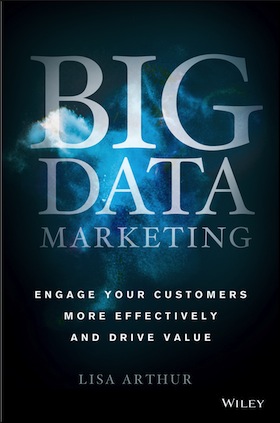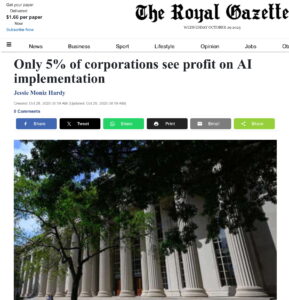
Guest post by Lisa Arthur, CMO of Teradata Applications and author of the new book Big Data Marketing (Wiley). Follow her on Twitter @LisaArthur.
Technology advancements are making it easier for people to constantly, effortlessly and sometimes unknowingly generate massive amounts of data every second. Lurking in the sprawling data pipelines of global corporations are complex tangles of information that have the potential to become your company’s most profitable resource. The opportunity has never been greater for savvy marketers and data analysts to team up and untangle the “data hairball,” gain insights into behavior, anticipate trends and make their customers’ experiences more relevant and timely. By working together on a more strategic level, they will have the competitive advantage they need to innovate, increase revenue and improve the bottom-line. The approach is called a data-driven strategy, which I outline in my new book.
This five-step roadmap is a summary of a data-driven approach covered in more detail in my book.
1. Get Smart. Get a Strategy. Develop a data-driven approach that will position your entire organization for customer-centric success.
All companies should begin with a vision and strategy. It will require some time investment, but will set you and your team on the right course over the long term.
The insurance and financial services leader Nationwide began feeling the cracks in their decentralized data silos back in 2005. They recognized the limitations of their existing systems and were missing the agility, speed and flexibility needed to succeed in its marketplace. They knew it was time to find a better way so they could deliver an “On Your Side” experience to their customers. With a system that had grown to more than 100 terabytes of user data, about 10 times the size of the entire printed U.S. Library of Congress, Nationwide had the vision to leverage its data as a strategic asset for true enterprise analysis and management. They wanted a data-driven approach so they could make forward-looking strategic and tactical business decisions. The effort began with the creation of a mission statement and formal vision for the project. Nationwide has executed that vision and, in the process, migrated from a product-centric company to a customer-centric company.
2. Tear Down the Silos. Become a highly responsive organization by fostering an environment of collaboration, coordination and connection.
Nearly 65 percent of marketers agree that silos within their marketing department prevent them from having a holistic view of a campaign across channels. Source.
Organizationally, marketers need to tear silos down within their own team and with IT and other organizations to put the customers at the center of their integration and interaction strategy.
There’s enormous value in using data together and proactively as a team. A great example from my book of tearing down the silos is happening at a company called International Speedway Corporation (ISC). They manage racetracks that host NASCAR events. They had a very key business imperative to be more relevant and data driven in engaging their fans. They have racetracks across the U.S. and each have different customers called guests or fans and they have different business requirements based on each event. So their IT and marketing teams worked together. They put all their data in one place. They were able to understand the holes in their data and were able to augment it. Today, they run over 1,100 different micro-segmented conversations all with no increased staff or cost. They’ve been able to improve the engagement with their fans in a more personal and relevant way. They saw revenue upside from their events and overall made bottom-line improvements.
3. Untangle the Data Hairball. Make sense of all your data, apply analytical insights and inform more innovative and relevant messaging.
So how do you access the data and use it to be more effective and efficient? How do you apply big data analytics to inform your marketing messages, to test real-time interaction strategies and to innovate your marketing engagement? How do you do this while data is constantly streaming in? As Brian Solis put it in a previous post about big data, are you “acting as a human algorithm and extracting insights with intention”?
The best way to get started is by defining a pilot project focused on a specific business objective. One example could be examining the path of interactions that lead to defecting customers. It’s less daunting to start with a discreet project where you can identify all triggers for customer attrition. Find data sources that apply. Use the pilot to analyze each online and offline channel including your call center and physical locations. Don’t just analyze everything that’s already in place. Use the pilot as an opportunity to experiment. Try new approaches and offers based on insights gained.
If you can successfully untangle one strand of the data hairball, you will have gained the experience and knowledge to tackle the next strand.
4. Make Metrics Your Mantra. Prove that your efforts increase business value by providing transparency and driving accountability into every layer of the marketing organization.
Raising the visibility and value of your data-driven marketing work is an essential part of the whole strategy.
In my CMO role, my team and I began our own journey toward becoming data-driven marketers. We developed a five-prong scorecard to report marketing’s contributions and value. The scorecard measured demand, customer satisfaction and retention, sales productivity, market category leadership and overall effectiveness of our team. We soon learned we didn’t have everything in place to track cross-channel interactions, yet. We decided to focus on a pilot – tracking cost per lead and the return on investment (ROI) with short-term goals and we reported our results at the board level. Over time, we established credibility and momentum and began to align metrics wider across the marketing organization and then the entire enterprise with larger, broader-based objectives.
5. Process is the New Black. Build modern, purposeful activities that are made possible by marketing technology and automation advances.
In order to truly embrace a data-driven marketing strategy, departments must operationalize the insights gained from analyzing data. Being agile enough to pivot to changing market conditions and big data insights plus further segment and personalize a creative execution is the new expectation that marketers must meet and that customers expect.
Marketing teams realize there are missed opportunities by not using data to drive marketing decisions faster. In fact, 45 percent of marketers agree that data is the most underutilized asset in the marketing organization. Source.
Using software tools to help automate processes can be helpful as roles, campaigns and data complexities increase. A tool like an integrated marketing management (IMM) system can help marketers process massive amounts of information and do things faster, more relevantly and with greater competitive advantage.
Our first mission, as always, is to develop trust with our customers. We do this by honoring the data they offer us, avoiding overly-intrusive communication techniques and understanding their purchase patterns and behaviors well enough so we can begin to proactively meet their needs. Then we deliver relevant messages and offers when and where our consumers want to receive them.
True one-to-one marketing is about having a conversation with one. As digital marketers embrace digital marketing attribution – the ability to understand an individual – our consumer relationships begin to operate on a much more intimate level. It’s here where true personal interactions versus broad marketing transactions exist and thrive.
It’s critical that we take the opportunity to dig in and understand the digital disruption that’s happening so we can create a true data-driven marketing revolution filled with a constant stream of insights. Perhaps this is an area where focus, funding and experimentation could be just the inflection point your business is needing.
Although big data is still a nemesis to many, it’s time to stop pushing back with safe and familiar marketing initiatives that no longer serve our customers. It’s time to make data friendly and use it to innovate. Let’s take marketing to a place where data is no longer something coming at us, but instead is a natural part of our thinking, processing and decision making. This is a huge, humbling and exciting opportunity to become trailblazers in the new world of big data marketing.
What’s been your experience as you wrangle with your company’s own data hairballs?





Very nice summary of how data is changing how we attain, and more importantly maintain, customer relationships.
Thanks for commenting!
Great post. The challenge, especially for big organisations, is untangling current systems or making them next gen ready.
Agree. The untangling of systems and the culture to drive change are two HUGE factors. Thanks for weighing in and the feedback!